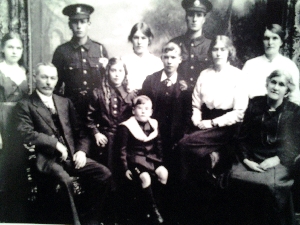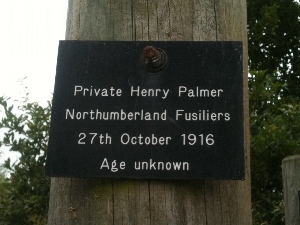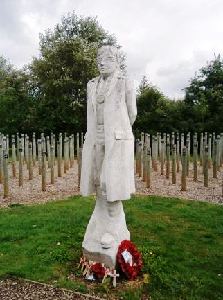
Family photo: Andrea Palmer

Plaque in Arboretum: Fiona Wallin

National Arboretum Memorial
Newcastle Journal Saturday 28/10/1916
Albert Communal Cemetery
Henry Palmer was born in Walker on the 18th October 1894, baptised on the 11th November 1894 at Walker Christ Church. His parents were Henry Palmer, (born in Workington, on the 6th September 1866, died 20th March 1941), and his wife Phillis or Phyllis Mayes, (born 1865, Whitehaven, died 1930). She was the daughter of James Mayes, born 1837, and his wife Jane nee Farrer, born 1838.
Henry was one of nine children. Robert, the eldest, was born on the 3rd August 1889 at Whitehaven and died in 1962. Mary, born at 32 Mark Street, Wallsend in September 1898, died in 1961. Creighton Ross, was born on the 22nd July 1900 at 32 Mark Street, Wallsend, died in 1978. Phillis, born in January 1902 at 32 Mark Street, Wallsend, died in 1953. Dora Maggie Dorothy, born in Wallsend in June 1904, died in 1955, Albert Edward, born 21st December 1909 at 171 Station Road, Wallsend, died in 1987. Agnes, born in 1891 at 123 Harriet Street, Byker, Newcastle-upon-Tyne, died in 1974. Ethel Maud, born in 1893 at Byker, died in 1942.
Henry Palmer, like his father, was a Coal Merchant, as was his elder brother Robert who was self employed.
In 1891, the family were living at 123 Harriett Street, Byker after moving from Whitehaven just after Robert was born.
By 1901 the family had moved to 32 Mark Street, Wallsend, Newcastle-upon-Tyne.
Henry was educated at St Peter's School, Wallsend from 1899 to 1902.
In 1911 they were residing at 171 Station Road, Wallsend.
Robert Palmer [Henry's older brother], in 1939 was residing at 51 Coach Road, Wallsend, Northumberland, and was a Shopkeeper Fish Fryer, married to Mary W, born 19th February 1894, they had two children, Elizabeth [Kober] Palmer, born 3rd February 1912, and a boy named Robert Palmer born on the 7th November 1918. He worked as a Plater in the Shipbuilding industry.
Albert Edward, Henry's younger brother, in 1939 was residing with his widowed, and retired father at 171 Station Road, Wallsend, Northumberland as a Fish Fryer. [This is where Albert had his Fish and Chip shop], he was single.
(A message from Albert Edward Palmer, received 11/12/2016, says: "I can confirm that Henry’s address was 171 Station Road. Henry would have been my uncle and his youngest brother (Albert Edward) was my father. I am also Albert Edward and was his only son born in 1948 at 171 Station Road. The fish and chip shop actually had the address of 173 Station Road.'
Creighton Ross Palmer in 1939 was residing at 3 Overfield Road, Newcastle-upon-Tyne, and was a Coal Filler in the local mine, he was married to Elizabeth Palmer who was born on the 8th August 1908].
Henry Palmer enlisted after the outbreak of World War 1 as a Territorial in the 1/5th Battalion, Northumberland Fusiliers at Walker. His service number was 5/3057.
The 1/4th 1/5th & 1/6th Battalions Territorial Force, were located on the 4th August 1914 at, 1/4th stationed at Hexham, the 1/5th stationed at Walker, Newcastle-on-Tyne and the 1/6th stationed at Northumberland Road, Newcastle-on-Tyne, both part of the Northumberland Brigade of the Northumbrian Division, part of the Tyne Defences. On the 20th April 1915, the were mobilised for war and landed in France at Boulogne from Southampton, on the S.S. Victoria, at 10.30 pm, where the formation became 149th Brigade of the 50th Division and engaged in various actions on the Western Front including; 1915, The Battle of St Julien, The Battle of Frezenburg Ridge, The Battle of Bellewaarde Ridge. 1916, The Battle of Flers-Courcelette, The Battle of Morval, The Battle of the Transloy Ridges. 1917, The First Battle of the Scarpe, The Capture of Wancourt Ridge, The Second Battle of the Scarpe, The Second Battle of Passchendaele. 1918, The Battle of St Quentin, The Actions at the Somme Crossings, The Battle of Rosieres, The Battle of Estaires, The Battle of Hazebrouck, The Battle of the Aisne.
Henry Palmer was charged with constructive desertion for at least three instances of being absent from his unit. He entered a not guilty plea, to each of the three charges. The first two charges he was found not guilty, mainly because of insufficient evidence.
His unit had been heavily involved in the Battle of Morval on the 25th September and on the 1st October 1916, just south of Le Sars.
Henry was found not guilty of the two earlier offences, which occurred in late September, but the third charge, on the 1st and 2nd October, he was found guilty and condemned to death.
Prior to this on Thursday 21st September he was attached to the Lewis Gun team. Whilst attached to this team he went missing attending to errands to the rear when sent. Lance Corporal John William Hadaway, service no. 240579, from North Shields was in the same Lewis gun team. There is mention in the War Diary of a Lewis gun team moving up to the front line after the other Lewis Gun team, gun had been knocked out.
At night patrols from the 1st, 50th and 23rd Divisions found the enemy had pulled out of Starfish and Prue trenches which where gradually occupied.
Location Martinpuich, M 33. a to M 35 D. The War Diary of the 1/5th Battalion for the 21st September reads as follows:- 7.30 pm Information received that STARFISH TRENCH has been evacuated by Germans, that Division on our right have entered it. 1/4th N.F., ordered to send forward parties to see if the trench is occupied in front of us.8.30pm Our working parties cancelled and two parties of 2 Officers & 100 men each 'A' 'C' and 'D' Coys, (with tools) sent up under orders of O.C 1/4th N.F., to support this operation.
Friday 22nd September, Starfish and Prue Trench were consolidated. Patrols reported that no Germans were south-west of Eaucourt l' Abbaye.
Battle of Transloy Ridge, 1st to the 18th October. Sunday 1st October. 50th Division. For the attack 151 Brigade consisted of 1/6th Durham Light Infantry (a composite Battalion made up of 1/5th Border Regiment and 1/8th Durham Light Infantry) and 1/5th Northumberland Fusiliers, (attached from 49 Brigade). The 1/6th Durhams, suffering in the wake of 1/17th London's lack of success, had their right flank exposed and only gained a footing in Flers trench. Their Commanding officer was wounded and so 1/9th Durhams, who were in support, cme up and rallied the front troops and by 9.30 pm elements of both Battalions had secured Flers Trench. In the centre and on the left the composite Battalion and 1/5th Northumberlands captured the Flers lines with little difficulty.
Lance-Corporal Hadaway, a prosecution witness at the trial, recalled that he and Private Palmer had climbed over the parapet together. However, the NCO had not seen Palmer again, although their company had halted twice and lay prone before reaching the objective. In the war diary it is recorded: The whole line disappeared over [the] ridge, and was obscured by smoke of bursting shells - our barrage opened very intense and we afterwards heard with excellent results. It was inferred at Henry Palmer's Court Martial that is was at this point that Palmer was seen no more. Also on the 2nd October around noon Palmer was observed making his way up a communication trench, where he was challenged, past Battalion Headquarters towards the front line. The soldier had no reason not to be in the firing line at this time, his unit not having been relieved. The Battalion H.Q was located at Crescent Alley being heavily shelled by the Germans. It was to be relieved that afternoon, but the shelling delayed the handover till the following day.
At Henry's trial prosecution witnesses were not cross-examined. Palmer told the court that he advanced in the attack but that he had been hit in the knee. However, he was unable to remember his whereabouts at the time of his alleged injury. He stated at first he was hit halfway across No Man's Land, later he said he was hit in front of the German Wire. In his first version of events, Palmer stated that after being hit he returned and stopped in a communication trench to have a rest. He could not find his unit on the following day, due to the heavy shelling.
When further questioned, he agreed that his injury had not caused him to report sick. Also he remarked that he threw his ammunition away when injured near the German Wire. He then returned to the British front line.
Henry Palmer was unrepresented and said very little in his defence. He also called no witnesses and did not ask any questions. This was noted by the court at the time.
The findings of the Court were passed up the Chain of Command. Lt General W P Pulteney, Corps Commander had noted: The Battalion fought well (in the action from which Palmer was absent) and has good discipline. I support the recommendation of the court: 'mercy'.
There is an additional note that reads There appears to be no need for an example to be made.
Sir Henry Rawlinson General, commanding the Fourth Army, confirmed his support for the Death Penalty, which was also confirmed by Field Marshal Haig using in his green fountain pen)Confirmed.
The Court Martial was made up of a Major, two lieutenants all from the Northumberland Fusiliers, but not from his battalion, and one Captain.
In the 1/5th Battalion War diary there is an entry which reads:- 'Millencourt 16/10/16, Training continues - Lecture to Senior Officers by Captain PALMER on 'Points to be noted at Courts Martial'
The Army Act stipulated that a Field General Court Martial should consist of a minimum of three officers, one of whom, not below the rank of captain, should act as president. A sentence of death could not be passed without the concurrence of all the officers making up the FGCM panel. Prior to a trial, the soldier would be offered the assistance of an officer to act as a 'prisoners friend' - Defending counsel.
He is reported as wounded in the Newcastle Journal for Saturday 28/10/1916.
Private Henry Palmer was executed on Friday 27th October 1916.
His brother, Robert Palmer, also served in the 1st World War.
The picture is of the whole family - his mum, dad, and three brothers and five sisters. His mum is Phyllis. His father Henry was a coal merchant, previously from Durham (prior to that Cumberland).
Shot at Dawn; Putkowski and Sykes; 1989; Leo Cooper; ISBN 0 85052 295 1.
Blindford and Alone: British Military Executions in the Great War; Corns and Hughes-Wilson; 2001; Cassell; 0 304 36449 5.
Henry Palmer is remembered at Wallsend on W7.03

